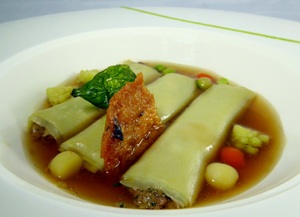Duck thighs
Category
Poultry
Seasonal period:
January, February, March
They can be prepared fresh or confit.
When we talk about “duck confit”, we refer to the thighs, even though many parts of the duck can be confit.
Nutritional information (0.1 kg)
Energy
214.0
kcal
Carbohydrates
0.0
g
Proteins
22.0
g
Lipids
14.0
g
Sugars
0.0
g
Salt (Sodium)
80.0
mg
Folic acid
25.0
ug
Vitamin C
3.0
g
Vitamin A
24.0
ug
Zinc
2.7
mg
Iron
2.0
mg
Calcium
10.0
mg
Cholesterol
75.0
mg
Polyunsaturated fatty acids
2.9
g
Monounsaturated fatty acids
5.8
g
Saturates
3.9
g
Fiber
0.0
g
The data is merely a guide and should not be used for medical purposes. Those responsible for the web disclaims any responsibility.
-
Type of dish
- Beers
- Cocktails
- Breakfasts and brunch
- Burguers
- Juices, milkshakes and beverages
- Shellfish
- Bread and pastries
- Pizzas, patty
- Dessert
- Pasta
- Sándwich
- Pastries
- Finger foods
- Ice creams and sorbets
- Legumes
- Salads
- Eggs
- Patty
- liqueur
- Harvard plate
- Main course
- Meats
- Fish
- Birds
- Vegetables
- Soups and creams
- Rices
- Coffee, chocolate and infusion
- Cheeses
- Appetizers and canapes
- Temperature
- Cuisine type
- Additional culinary preparation
- Conservation technique
- Seasonal recipes
-
- Aromatic herbs
- Beverages
- Big game hunt
- Bread and pastries
- Canned goods and pickles
- Cereals
- Condiments, spices and additives
- Cooked, salted, preserved and cold meats
- Dried fruits and nuts
- Dry pulses
- Edible oils and vinegars
- Eggs and derivatives
- Feathered game hunt
- Fish cuts
- Fishes
- Insects
- Kitchen and bakery tecniques
- Kitchen and bakery utensils
- Meat cuts
- Meats
- Milk, cream and derivatives
- Mushrooms
- Offal
- Pasta, rice, flour and derivatives
- Poultry
- Seafood
- Service techniques
- Service utensils
- Vegetables cuts
- Vegetables, fruits, tubers and seaweed


